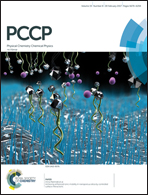Reduced graphene oxide/liquid crystalline oligomer composites based on reversible covalent chemistry†
Abstract
As the properties of materials can be determined by their structures, a novel liquid crystalline oligomer (LCO) was first designed and prepared. The LCO possessed reactivity with reduced graphene oxide (RGO) and could be used to modify RGO. Maleimide groups could be grafted onto the RGO surface via the Diels–Alder reaction, whereby the mesogenic units enable the LCO to have optical rotation and excellent liquid crystalline properties, while the carboxyl groups could improve the dispersibility of RGO in solvents and disperse more TiO2 on the surface of modified RGO than on pure RGO. Spectroscopic tools (Raman and XRD) were used to confirm the completion of the reaction. A Fourier transform infrared imaging was utilized to analyze the dispersibility of RGO in the RGO–LCO composites. Differential scanning calorimetry (DSC) and thermal gravimetric analysis (TGA) were used to determine the thermal properties of the composites. Due to the excellent thermal property of RGO and the interactions between RGO and LCO, the dispersed RGO can increase the decomposition activation energy and the glass transition of composites. RGO can enhance the photocatalytic degradation of TiO2 due to its high electron mobility and large specific surface area. By preventing the aggregation of TiO2 and RGO, thus improving the solubility and dispersion stability of the RGO and increasing the affinity of RGO to TiO2, the LCO-modified RGO was better than pure RGO to enhance the photocatalytic degradation efficiency of TiO2.



 Please wait while we load your content...
Please wait while we load your content...